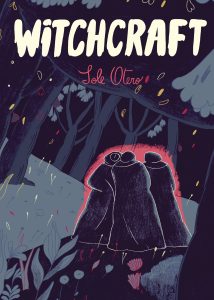 Witchcraft
Witchcraft
Cartoonist: Sole Otero
Publisher: Fantagraphics
Publication Date: October 2025
Sole Otero’s 2023 graphic novel Witchcraft is a monumental work of historical fiction with small but significant touches of supernatural horror. The story revolves around three witches who came to Argentina in 1768 with benevolent intentions but must nevertheless defend themselves from the explosive violence of a society that hates them.
Witchcraft is primarily set in Buenos Aires, and the narrative jumps between historical periods when the witches were active and the present day, when the gender politics of their activities are far more complicated. It would be easy to see the witches as feminist saviors as they run women’s clinics and shelter members of the local indigenous population, but their benevolence is called into question by the nature of their magic, which requires the victimization of men and the silent complicity of their fellow women. Instead of a feminist message, what Witchcraft offers is a fast-paced and high-stakes story about cycles of abuse and the human cost of the sacrifices necessary for the marginalized to survive.
The first chapter introduces the witches from the perspective of an aging Millennial man who tells his friend a tall tale that would sound like an urban legend if he hadn’t actually experienced it himself. When his upstairs neighbor suddenly starts having constant (and remarkably loud) sex, the man stakes out her apartment and learns that her boyfriend is none other than their landlord, whom he follows to an abandoned building in a formerly prosperous neighborhood. What he sees there is incredible: a circle of women performing an occult ritual around the prone and unresponsive bodies of several naked men.
Though he leaves the sordid details out of the story he tells his friend, the man has a prurient interest in this nightly ritual. His obvious arousal is more than a bit pathetic, especially since his wife is busy with work and isn’t interested in him, sexually or otherwise. As the man’s friend explains, this is partially his own fault for marrying a Catholic girl straight out of high school, and Otero’s clever visual framing of his story allows the reader to see the context of how and why the coven of witches is able to entrap men exactly like him.
Witchcraft initially seems like a story about girl power, but each successive chapter adds a new complication to the concept of “power.” In the generation prior to the present, for instance, the witches take in a girl who was horrifically abused at a Catholic orphanage. Though this act of charity is undeniably good, it’s up to the reader to decide whether the girl’s trauma justifies her decision to join a coven that subjects young men to a similar type of abuse. The ethics of this situation are further complicated by the fact that the witches have used their wealth and longevity to monopolize the city’s real estate market, thus making it difficult for their victims to escape their influence.
Sole Otero’s boldly stylized and kinetic artwork does justice to an emotionally complex story about witches, cults, riots, discrimination, freedom, and flight. Each character in the sprawling cast is visually distinct, as is each time period. In addition, each section of the story is narrated in a different voice with its own comic style, some of which are extremely creative.
I was especially impressed by the chapter in which one of the witches’ male victims enters into a prolonged email conversation with a woman who suffers from anxiety so severe that she’s unable to leave her apartment. Even as the woman’s daily activities are depicted in increasingly smaller panels, the windows of her email browser remain open and spacious. Unfortunately, this digital connection is insufficient to dispel the visual claustrophobia engendered by the fear of being observed by hostile outsiders, and Otero’s paneling emphasizes the bleakness of the lives of two people who have nothing but good intentions yet are too weak to help one another.
Witchcraft is a massive book, but it moves quickly and pushes its story forward with incredible momentum. Otero’s twists keep the reader guessing, encouraging sympathy for one set of characters before steering the narrative in a surprising new direction. Andrea Rosenberg’s translation is excellent, distinguishing between voices for different characters and time periods without relying on campy dialects.
Fans of the unsettling magical realist fiction of Mariana Enriquez or the history-inspired horror comics of Julia Gfrörer will feel at home with Witchcraft, a boldly colorful and thrilling page-turner and a haunting meditation on how historical cycles of power and exploitation still echo through modern-day Buenos Aires.
You can also check out an exclusive excerpt right here on The Beat.
Witchcraft is available from Fantagraphics.
Read more great reviews from The Beat!























 English (US) ·
English (US) ·